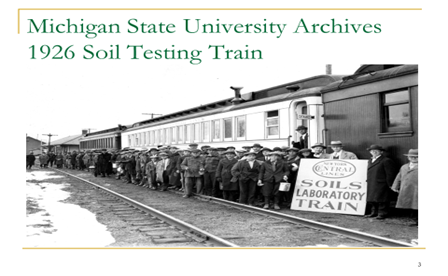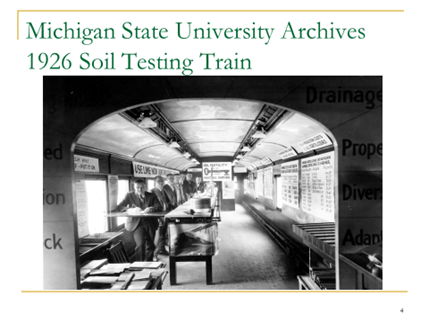A century of soil testing in Michigan
Jon Dahl discusses the changes and challenges of soil testing in Michigan for almost a century.

After nearly 40 years of managing the Michigan State University Soil and Plant Nutrient Lab, Jon Dahl has distinguished himself as a leading expert on Michigan soils. Dahl received his master’s of science in crop and soil sciences from MSU. He has since analyzed hundreds of thousands of soil samples and given advice on fertility for over 175 different crops. Dahl retired from MSU in 2022. Michigan State University Extension educators Brent Crain and Christina Curell recently had the pleasure to ask Dahl about his experiences at the Soil and Plant Nutrient Lab. Here’s what he had to say.
How did the MSU Soil and Plant Nutrient Lab get established?
Soil testing at MSU started back in the 1920s. At that time the testing was performed on rail cars that were moved around the state to various locations (see photos). Soils were tested for pH, phosphorus and potassium using quick test colorimetric type procedures. In the 1930s, soil testing trucks traveled around Michigan. In the late 1940s, a central soil testing lab was set up at Michigan State College (now MSU). County soil testing labs were also established. By 1959 there were 60 county testing labs. In 1962, the central lab recommendations were computerized and county labs began to be phased out.


What changes have you seen over time in soil nutrients?
There is little information on soil test levels prior to 1962. In 1962, a soil test summary by county was started for samples going through the lab. Since that time, soil test phosphorus levels went from about 10 parts per million (ppm) (low) to 55 ppm (very high) in the mid-1980s. Since that time, through education we have seen the levels come back down to around 45 ppm. Soil test potassium levels have gone from around 55 ppm to currently around 90 ppm. Soil pH levels really haven’t changed much over this time period.
Editor’s note: High phosphorus levels in soil lead to water quality problems, destabilizing the ecological balance in lakes and causing excessive growth of aquatic plants and algae. Fertilizer containing phosphorus should be used only when indicated and not applied to lawns.
What challenges do you see for agriculture growers for soil fertility?
Potassium is probably the biggest challenge for growers. While levels have come up over time, there is still a great need for potassium on a large number of Michigan soils. Particularly on sandy soils and northern Michigan soils, potassium remains a limiting factor for higher yields. On these sites you can’t build up potassium in the soil very well so it must be applied in adequate quantities each year.
What challenges do you see for homeowners for soil fertility?
Again, potassium is a big issue for homeowners and getting more homeowners to soil test so they recognize the need is vital. For urban homeowners, high soil pHs can cause micronutrient deficiencies in trees and shrubs and gardens. Trying to lower the soil pH with sulfur is not an effective option on many of these soils because without constant sulfur application the pH will just bounce back up. Applying micronutrients on these high testing soils is a more effective option.
When should a micronutrient analysis be ran?
I generally don’t recommend micronutrient analysis for home lawns and gardens. Lawns will generally grow well even above pH 8.0 without micronutrient addition. For gardens, if you are seeing yellowing of the plants or striping on the leaves, you are best off applying a general micronutrient fertilizer rather than testing. Soil tests for the micronutrients aren’t always a reliable indicator of need. If you need verification of a micronutrient deficiency on a tree or shrub, you are better off doing a leaf analysis. For farm samples, if your soil pH is above 7.0, you may want to analyze your soil for zinc and manganese if you are growing a crop with high requirements (see Extension Bulletin E-486, Table 4 for response of selected crops to micronutrients). These soils are most often found in the Thumb area, southeast Michigan or other areas with limestone as the parent material.



 Print
Print Email
Email